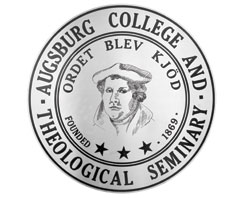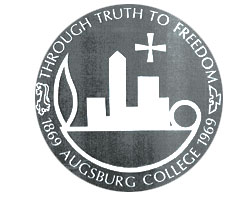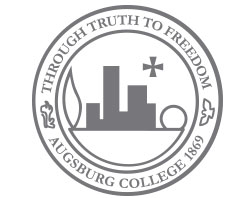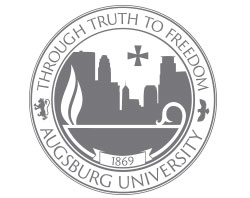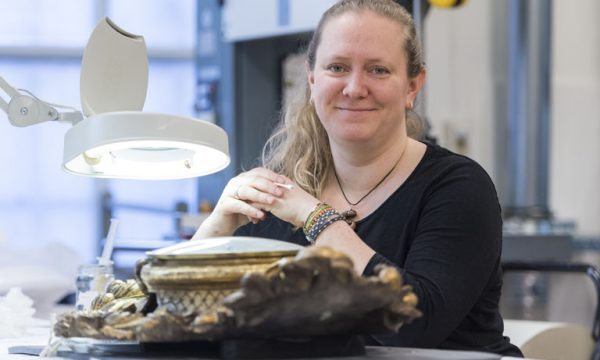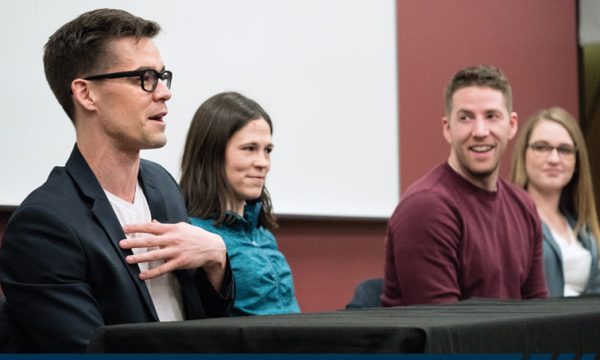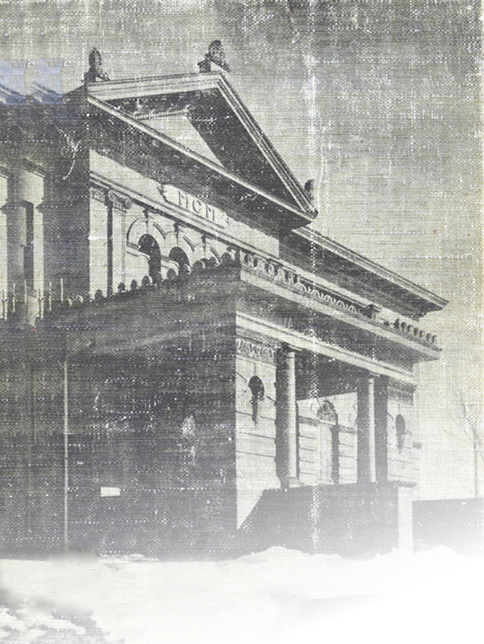 On September 1, “Augsburg College” officially will become “Augsburg University”—a change approved by both the Board of Regents and the Augsburg Corporation.
On September 1, “Augsburg College” officially will become “Augsburg University”—a change approved by both the Board of Regents and the Augsburg Corporation.
For generations of Augsburg alumni and friends, it may seem like the place always has been called “Augsburg College.” That’s been the formal name of the school for the past 54 years.
Over the course of the school’s history, nearly 24,000 people have completed degrees at Augsburg. With so many Auggie alumni accustomed to thinking of Augsburg as a college, why change the name?
In short, the term “university” illustrates the breadth of Augsburg’s current reality and goals for the future. And, “while our name is changing,” said Augsburg President Paul C. Pribbenow, “the essence of who we are is not.”
As the first seminary created by Norwegian Lutherans in America, the name Augsburg—chosen by the school’s founders in 1869 to honor the Augsburg Confession—always has defined the ethos of this institution and its mission to support those called to service in the world. Since its founding, Augsburg has been known by at least four different names. The name has shifted as the school has grown, but our commitment to an accessible, quality education has never wavered. Likewise, our dedication to the Lutheran principles of hospitality, service to the neighbor, and social justice is as steadfast today as ever.
In announcing the name change, Pribbenow affirmed that becoming Augsburg University “does not alter our dedication to integrating the liberal arts and professional studies or our commitment to being small to our students and big for the world.”
Rather than moving Augsburg away from its roots, the name change helps Augsburg remain both faithful to its heritage and relevant to the educational needs of students in the 21st century.
Ever evolving, always Augsburg
Growth in graduate programs
From its early years, Augsburg stressed that a good education is practical and focused on educating ministerial candidates and theological students as well as farmers, workers, and businesspeople.
So, it’s no surprise that Augsburg today offers a number of professional master’s and doctoral degrees — a mix of programs that makes Augsburg already more like a university than a college. While there is no fixed definition outlining the distinction between a “college” and a “university,” offering post-baccalaureate degrees commonly is associated with institutions named as universities.
Augsburg’s first advanced degree program, the Master of Arts in Leadership, launched 30 years ago. Since then, 3,700 people have earned master’s or doctoral degrees from Augsburg. This past fall, Augsburg’s graduate enrollment reached a record high—representing 28 percent of total enrollment—and continued growth in Augsburg graduate programs is anticipated in the coming years.
Augsburg Name Change History
1869
Augsburg Seminarium
1872
The Norwegian Danish Evangelical Lutheran Augsburg Seminary
1892
Augsburg Seminary
1942
Augsburg College and Theological Seminary
1963
Augsburg College
2017
Augsburg University
An international perspective
Today, Auggies live and work all over the world. In many countries and cultures, the word “college” is associated with a high school-level education. Alumni who work in international settings have noted that they already refer to their alma mater as “Augsburg University” in order to avoid confusion. For the same reason, the name change also will help Augsburg be more attractive as a destination for international students, which represents a potential growth area for Augsburg.
A view from the outside in
With nearly 150 years of history, it’s no surprise that Augsburg is well known in the region—even among people who haven’t (or haven’t yet) studied here. What impact would a name change have on their perceptions of Augsburg? We asked the following groups to share their thoughts:
- high school students,
- parents of high school students,
- high school counselors,
- people considering getting an advanced degree, and
- people who didn’t finish an undergraduate degree right after high school and are thinking about going back to school to earn a bachelor’s.
These conversations generated several important insights, but the core takeaway is that Augsburg’s reality, reputation, and promise are aligned with the name change.
Our reality and reputation. Conversations with members of the general community demonstrated that people associate the word “university” with a number of attributes that clearly apply to Augsburg. Specifically, people view universities as having high academic standards, a commitment to research, strong international programs, and diverse student populations.
Augsburg has robust programs for scholarly research and global study, and is recognized nationally for its leadership in inclusion and equity. In many ways, Augsburg already embodies much of what people expect of a university.
The promise of a student-centered university. We also learned from these conversations that Augsburg has a strong reputation for direct student-faculty engagement. We already know how important this is to our alumni, students, faculty, and staff, but it was gratifying to hear that members of the broader community also value Augsburg as a student-centered organization.
This is something Augsburg needs to ensure does not change. Augsburg University will not become an institution marked by big campuses or large student-to-faculty ratios. Instead, as is articulated in our Augsburg2019 strategic vision, Augsburg will be a new kind of student-centered university, and just as we have done for decades, Augsburg will remain committed to educating students for lives of purpose in a vibrant, engaged learning community.
The visual identity of Augsburg University
Embracing our legacy and our future
When Samuel Gross ’03 was a student at Augsburg, he designed the original Auggie eagle-head symbol as an assignment for one of his graphic design courses. The design was so good, Augsburg ended up buying the rights to the image and has used the eagle symbol for campus life, student organizations, and athletics for the past 15 years.
During that time, Gross became an award-winning designer and creative director who founded his own graphic design firm, 144design, with a specialty in developing logos for clients. So, when Augsburg needed to update its logo as part of the transition to the Augsburg University name, it was a perfect opportunity to re-engage with Gross to envision and design the next-generation Augsburg logo.
“Early on, our conversation about the logo confirmed that this project should be an evolution of the Augsburg brand, not a revolution,“ Gross said. “We wanted to preserve the strong recognition that has been built for Augsburg over time.
“Our goal was to preserve and respect the historic nature of Augsburg’s logo — especially since it already has strong energy and good familiarity — while at the same time creating a treatment that also embraces the future,” he said.
The results, including the updated Augsburg logo, “A” icon, and eagle-head symbol are shown on the next page. Separately, the Augsburg seal—which is used on transcripts, diplomas, and other official documents—was updated by Augsburg staff Mark Chamberlain and Denielle Johnson ’11 and is shown below.
Augsburg marks: honoring the legacy
The Augsburg logo
The Augsburg University logo is designed to feel similar to people who are already familiar with the College logo, connecting the new design with Augsburg’s legacy. In the new logo, the word “Augsburg” is more bold than the word “University.” This approach reflects research findings indicating that people’s strong associations are with the name, “Augsburg,” whether or not it is followed by “College” or “University.”
The logo design also introduces different type treatments for the two words—with the font for “Augsburg” conveying an established, academic feel, and the font for “University” providing a sleek, contemporary balance. The contrast of the two words creates a dynamic energy.
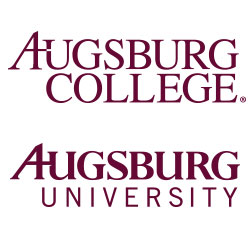
The Augsburg “A”
By strengthening the design of the “A” icon — broadening its base and making the vertical strokes bolder — Augsburg will be able to use the “A” icon as a standalone graphic element much more frequently and effectively going forward.For example, current plans call for the “A” icon to be installed on the shorter ends of the sign on top of Mortensen Hall. This is one of the most visible signs in the region and will be updated this summer as part of the transition to “Augsburg University.”
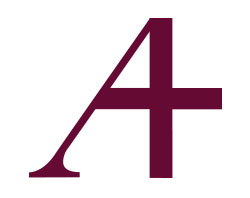
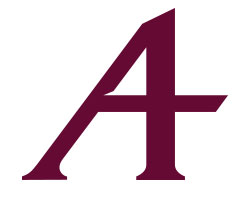
The eagle-head symbol
The eagle-head symbol is stronger and bolder with this evolution. Whereas the original design lost detail
and contrast when translated to black-and-white treatments, the updated design is much more effective across a broader range of uses.
Currently, designs using the updated eagle-head symbol are under development for an array of installations—from the Si Melby gym floor and the Edor Nelson athletic field scoreboard to the Christensen Center student lounge and merchandise sold in the Augsburg bookstore.
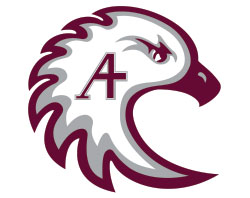
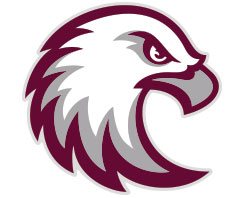
Augsburg University seal: history and meaning
The seal conservation process began as Augsburg College explored the steps involved in changing its institutional name to Augsburg University. The seal enhances an original centennial symbol design and aligns with the institution’s current reality, reputation, and promise.
